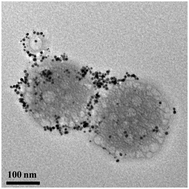pH and thermo-responsive tetronic micelles for the synthesis of gold nanoparticles: effect of physiochemical aspects of tetronics†
Abstract
Micelles of the star shaped block polymers “tetronics” were employed for the synthesis of gold (Au) nanoparticles (NPs) under the effect of pH and temperature variation. The presence of the diamine core in the tetronic macromolecule made its micelles highly pH responsive, thereby dramatically altering the physiochemical properties. Likewise, a high degree of hydration made the micelles temperature sensitive. UV-visible studies, transmission electron microscopy (TEM), gel electrophoresis, and structure optimization by energy minimization were applied to understand the physiochemical aspects of tetronic micelles and their further role in the synthesis of Au NPs. Synthesis of Au NPs was triggered by the surface cavities of the micelles and hence the NPs simultaneously adsorbed on the micelle surface. Low pH induced high hydration and temperature responsive well defined vesicular morphologies bearing Au NPs, while high pH produced mainly large and compact compound micelles carrying NPs. Both pH and temperature responsive behaviors of different tetronics significantly influenced the synthesis of Au NPs and thus demonstrated their ability to act as nanoreactors for the materials synthesis under different experimental conditions.


 Please wait while we load your content...
Please wait while we load your content...